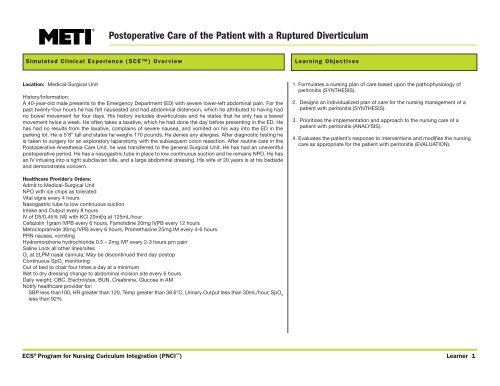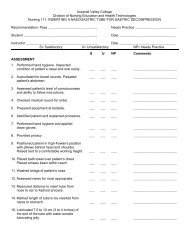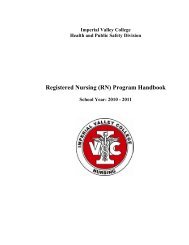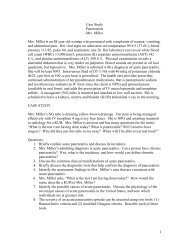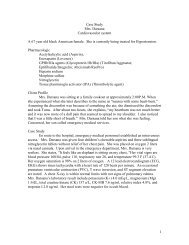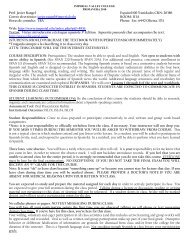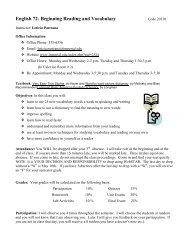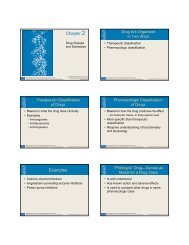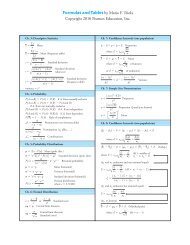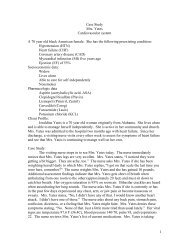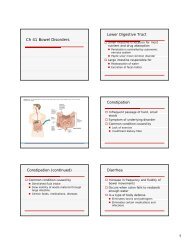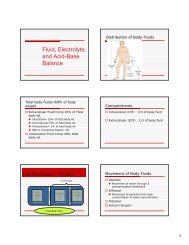ECS Ruptured Diverticulum (Learner).indd
ECS Ruptured Diverticulum (Learner).indd
ECS Ruptured Diverticulum (Learner).indd
You also want an ePaper? Increase the reach of your titles
YUMPU automatically turns print PDFs into web optimized ePapers that Google loves.
Postoperative Care of the Patient with a <strong>Ruptured</strong> <strong>Diverticulum</strong>Simulated Clinical Experience (SCE) OverviewLearning ObjectivesLocation: Medical-Surgical UnitHistory/Information:A 40-year-old male presents to the Emergency Department (ED) with severe lower-left abdominal pain. For thepast twenty-four hours he has felt nauseated and had abdominal distension, which he attributed to having hadno bowel movement for four days. His history includes diverticulosis and he states that he only has a bowelmovement twice a week. He often takes a laxative, which he had done the day before presenting in the ED. Hehas had no results from the laxative, complains of severe nausea, and vomited on his way into the ED in theparking lot. He is 5’8” tall and states he weighs 170 pounds. He denies any allergies. After diagnostic testing heis taken to surgery for an exploratory laparotomy with the subsequent colon resection. After routine care in thePostoperative Anesthesia Care Unit, he was transferred to the general Surgical Unit. He has had an uneventfulpostoperative period. He has a nasogastric tube in place to low continuous suction and he remains NPO. He hasan IV infusing into a right subclavian site, and a large abdominal dressing. His wife of 20 years is at his bedsideand demonstrates concern.1. Formulates a nursing plan of care based upon the pathophysiology ofperitonitis (SYNTHESIS).2. Designs an individualized plan of care for the nursing management of apatient with peritonitis (SYNTHESIS).3. Prioritizes the implementation and approach to the nursing care of apatient with peritonitis (ANALYSIS).4. Evaluates the patient’s response to interventions and modifies the nursingcare as appropriate for the patient with peritonitis (EVALUATION).Healthcare Provider’s Orders:Admit to Medical-Surgical UnitNPO with ice chips as toleratedVital signs every 4 hoursNasogastric tube to low continuous suctionIntake and Output every 8 hoursIV of D5/0.45% NS with KCl 20mEq at 125mL/hourCefazolin 1gram IVPB every 6 hours, Famotidine 20mg IVPB every 12 hoursMetoclopramide 30mg IVPB every 6 hours, Promethazine 25mg IM every 4-6 hoursPRN nausea, vomitingHydromorphone hydrochloride 0.5 – 2mg IVP every 2-3 hours prn painSaline Lock all other lines/sitesO 2at 2LPM nasal cannula; May be discontinued third day postopContinuous SpO 2monitoringOut of bed to chair four times a day at a minimumWet to dry dressing change to abdominal incision site every 6 hoursDaily weight; CBC, Electrolytes, BUN, Creatinine, Glucose in AMNotify healthcare provider for:SBP less than100, HR greater than 120, Temp greater than 38.6°C, Urinary Output less than 30mL/hour, SpO 2less than 92%<strong>ECS</strong> ® Program for Nursing Curiculum Integration (PNCI )<strong>Learner</strong>1
Questions to Prepare for the Simulated Clinical ExperienceReferences1. Define diverticulitis.2. For a patient with a ruptured colon, what major complications can be anticipated?3. I dentify the clinical manifestations of inadequate oxygenation in the postoperative patient:a. CNSb. CVc. Integumentaryd. Pulmonarye. Renal4. Identify potential problems in each system in the postoperative period:a. Psychosocialb. CVc. Respiratoryd. GIe. Urinaryf. Integumentaryg. Fluid and Electrolyte5. Discuss the nursing management of the postoperative abdominal surgery patient.6. I dentify the top three priorities for the nursing management of a postoperativeabdominal surgery patient.7. Identify three nursing diagnoses for this type of patient.8. Discuss the following types of IV solutions utilized in the care of postoperativepatients and identify at least two specific solutions for each:a. Hypotonicb. Isotonic9. What is the function of the peritoneum?10. Discuss the pathophysiology and potential causes of peritonitis.11. What are the clinical signs and symptoms of peritonitis?12. What is the prognosis for patients with peritonitis?13. Surgery and volume support are the primary interventions for secondary peritonitis,explain how volume support and possibly surgery aid in the treatment of peritonitis.References:Ambrosetti P., Jenny A., Becker C., Terrier T. F., and Morel P. (2002). Acute left colonicdiverticulitis-compared performance of computed tomography and water-soluble contrastenema: Prospective evaluation of 420 patients. Diseases of the Colon and Rectum. 43, 1363.Gordon, P. H. (1999). Diverticular disease of the colon. In P. H. Gordon and S. Nivatvongs(Ed.). Principles and practice of surgery for the colon, rectum and anus (2nd ed.). Los Angeles:Quality Medical.Gooszen, A. W., Tollenaar, R. A. E. M., Geelkerken, R. H., Smeets, H. J., Bemelman,W. A., Van Schaardenburgh, P., et al. (2001). Prospective study of primary anastomosisfollowing sigmoid resection for suspected acute complicated diverticular disease.British Journal of Surgery, 88, 693-697.Guyton, A. C. and Hall. J. E. (2006). Textbook of medical physiology (11th ed.).Philadelphia: Saunders.Ignatavicius, D. D. and Workman, M. L. (2006). Medical-surgical nursing: Criticalthinking for collaborative care (5th ed.). Philadelphia: Saunders.Jensen, D. M., Machicado, G. A., Jutabha, R., and Kovacs, T. O. (2000). Urgentcolonoscopy for the diagnosis and treatment of severe diverticular heamorrhage. NewEngland Journal of Medicine, 342, 378.Joanna Briggs Institute for Evidence Based Nursing and Midwifery. (2005). Bestpractice: Vital signs, 3(3). Retrieved May 30, 2005 from http://www.joannabriggs.edu.au/best_practice/bp8.phpKoger, K. E., and Shatney, C. H. (1996). Perforated jejunnal diverticula. AmericanSurgeon, 62(1), 26-32.Lawrence, S. J., and Mundy, L. M. (2004). Treatment of infectious diseases. In G. B.Green, I. S. Harris, G. A. Lin, and K Moylan. (Eds.), The Washington manual of medicaltherapeutics (31st ed.), 309. Philadelphia: Lippincott.McGee, S. (2007). Evidence-based physical diagnosis (2nd ed.). Philadelphia:Saunders.Mosby Staff. (2006). Mosby’s Drug Consult 2006. St. Louis: Mosby.Pagana, K. D., and Pagana, T. J. (2006). Mosby’s manual of diagnostic and laboratorytests (3rd ed.). St. Louis: Mosby.Prakash, C. (2004). Gastrointestinal diseases. In G. B. Green, I. S. Harris, G. A. Lin, andK. Moylan. (Eds.), The Washington Manual of Medical Therapeutics (31st ed.) 369-370.Philadelphia: Lippincott.Registered Nurses Association of Ontario. (2002). Assessment and management ofpain. Toronto: Registered Nurses Association of Ontario.Springhouse. (2003). Best practices: A guide to excellence in nursing care.Philadelphia: Lippincott.Stabile, B. E. and Arnell, T. D. (2003). Diverticular disease of the colon. CurrentDiagnosis and Treatment in Gastroenterology. New York: McGraw-Hill.Standards Task Force. (2000). Practice parameters for the treatment of sigmoid diverticulitis-supporting documentation. Diseases of the Colon and Rectum, 43, 289.<strong>ECS</strong> ® Program for Nursing Curiculum Integration (PNCI ) Postoperative Care of the Patient with a <strong>Ruptured</strong> <strong>Diverticulum</strong>© 2007 METI, Sarasota, FL; Authors: Thomas J. Doyle, METI and Russ George, Texas Woman’s University-Dallas. v.3 June 2007<strong>Learner</strong>2


